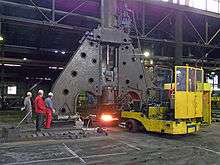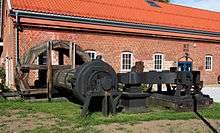Power hammer

Power hammers are mechanical forging hammers that use a non-muscular power source to raise the hammer preparatory to striking, and accelerate it onto the work being hammered. Also called "Open Die Power Forging Hammers." They have been used by blacksmiths, bladesmiths, metalworkers, and manufacturers since the late 1880s, having replaced trip hammers.
Design and operation

A typical power hammer consists of a frame, an anvil, and a reciprocating ram holding a hammer head or die. The workpiece is placed on the lower anvil or die and the head or upper die strikes the workpiece. The power hammer is a direct descendant of the trip hammer, differing in that the power hammer stores potential energy in an arrangement of mechanical linkages and springs, in compressed air, or steam, and by the fact that it accelerates the ram on the downward stroke. This provides more force than simply allowing the weight to fall. Earlier designs like trip hammer, steam drop hammers, board or strap hammers, use the power source to raise the ram, but let its fall be propelled solely by gravity.
Power hammers are rated by weight of moving parts that act directly on the work piece. This includes the weight of the parts that may consist of upper die, ram, mechanical linkage arms and spring(s) or ram, piston, and associated connecting rod(s). Specific design elements are dictated by the power source. The largest power hammer was powered by steam and was rated at 125 short tons (113 t).[1]
Types
Power hammers are generally categorized by their power source.
Steam
Steam hammers use steam to drive the hammer. These tended to be the largest models as the great energy of steam was needed to operate them. Locomotive works was one location such large hammers were needed. The workpieces were sometimes so large it required an overhead crane and several men to position the piece in the hammer, and a man to operate the machine.
Mechanical

These hammers tended to be smaller and were operated by a single man both holding the workpiece and operating the machine. The majority of these mechanical linkage machines were powered by line shaft flat belt systems or later electric motors that rotated a crank on the machine that drove the ram.
Air
Air-power hammers use pneumatics to drive the hammer.
History
Steam and mechanical power hammers were made into the middle of the 20th century in the United States. At the end of the 19th century the mechanical power hammer became popular in smaller blacksmith and repair shops. These machines were typically rated between 25 and 500 pounds of falling weight. Many may still be seen in use in small manufacturing and artist-blacksmith shops today. In the middle of the 20th century power hammers driven by compressed air began to gain popularity and several manufacturers are currently producing these hammers today.
References
- ↑ Factory and industrial management, 5, McGraw-Hill, 1893, p. 810.
Further reading
- Freund, Douglas, Pounding Out The Profits, Mingus Mountain Machine Works, Jerome AZ, 1997 ISBN 0-9657652-0-2